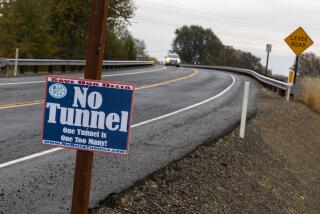Toiling to Finish the Toll Road System
- Share via
Orange County’s toll road agency is poised today to gamble $16.5 million on a design for the final link in its countywide tollway network, even though two federal agencies that must sign off on the project are questioning whether the road is needed at all.
The U.S. Army Corps of Engineers and the U.S. Environmental Protection Agency have repeatedly voiced doubts about the project, including whether future traffic demands support the need for a $644-million toll road connecting Oso Parkway with Interstate 5 in South County, according to federal documents.
“We continue to have significant concerns regarding the project purpose and need, the lack of defined study area, and the use of outdated information,” a top U.S. Army Corps regulatory official wrote federal highway officials last fall.
Those concerns have not dissuaded the toll road leaders from pushing forward with their timetable, which has them voting today on spending a nonrefundable $16.5 million for a preliminary design for the 16-mile stretch of roadway. Several of those leaders contacted Wednesday shrugged off the federal scrutiny as “standard fare.”
But if those federal agencies do not agree the road is needed, completing the project would be arduous, said Brad Keazer, assistant division administrator with the Federal Highway Administration in Sacramento.
“It is still possible, but it is very difficult,” Keazer said Wednesday.
The dispute is so intense that if no agreement is reached by next week, it may trigger a special arbitration process never before used in California, federal officials said.
“This is relatively unusual. Normally, we don’t have these kinds of issues on a project,” said David Carlson, an EPA scientist who has reviewed the plans. Regarding today’s vote by the Transportation Corridor Agencies, Carlson said: “I’d wonder what the contractor is going to design and engineer. We haven’t determined that yet. That would be at [the toll road agency’s] risk.”
The dispute has reached all the way to Washington. Three Orange County congressmen sent a terse letter dated May 4 to several key figures, including U.S. Interior Secretary Bruce Babbitt and EPA Administrator Carol Browner, complaining of the delay and saying the Army Corps, EPA and the U.S. Fish and Wildlife Service “have raised issues that seem clearly to be beyond the realm of their respective legislative authorities.”
The letter is signed by U.S. Reps. Loretta Sanchez, Ron Packard and Dana Rohrabacher.
Environmentalists have long fought plans for Foothill South, contending it would cut through one of the most pristine natural habitats in Southern California, marring plans for a major wildlife preserve there. But road supporters say it is needed to ease the traffic congestion they expect will be generated by future growth in South County.
The proposed four-lane segment would create an inland route its builders say will provide much-needed relief for future commuters. The exact path it would follow remains undecided. Toll road builders favor the easterly CP alignment, but environmentalists denounce that route and say the westerly BX route is less damaging.
There is a certain risk in the toll road agency investing the $16.5 million without the federal approvals in place, said project spokeswoman Lisa Telles, but the same practice effectively shaved time off building other toll roads, including the Foothill’s northern section.
The design phase will also provide key data needed to respond to federal agencies and critics of the plan, she said.
“We can’t answer a lot of those questions without the preliminary engineering done,” Telles said. “You can’t continue this process without the answers we’re going to get in this phase.”
Board members also said they see little chance of the project falling through.
“We’re taking that much of a risk because we feel strongly about what we’re trying to do,” said Harold Kaufman, chair of the board’s finance committee. “We see it as a minimal risk, really. We’re confident we’re going to get the project through in [one form] or another.”
Kaufman, a Dana Point councilman, said his confidence is bolstered every time he drives home from San Diego on a Sunday night and is confronted by gridlock on Interstate 5. There is a clear need for another option, he said.
“I don’t have a problem justifying the need for the roads to the federal government or to anyone else,” Kaufman said. “I don’t want to sound like a Pollyanna. But this just makes sense.”
Federal officials have a different view.
To date, both the EPA and the Army Corps have issued several strongly worded letters questioning TCA’s rationale for the road and the quality of their data. EPA’s staff, for instance, questioned claims that the current roadway system is inadequate, stating in one letter: “It appears that there are no current deficiencies on the road network.”
Orange County Supervisor William G. Steiner said the strong skepticism expressed by federal officials is “standard fare” for projects of this scope. While the issues “must be seriously considered and addressed,” he said he doubted the project would be jeopardized by the gauntlet of federal agencies.
In the end, Steiner said, the “evident need” for the extension will propel the project forward. Without the Foothill South extension, he said, the unfinished corridor would “just be hanging out there” and of limited value to the region’s commuters.
But some environmentalists think TCA will be closing out valuable options by approving the contract today.
“To me, it’s like digging a hole, and eventually they’re going to say we can’t get out of this hole. And to me, it should not be tolerated,” said Dan Silver, coordinator of the Endangered Habitats League, a Los Angeles-based environmental group. “We certainly don’t know if the road is needed. And that is a fundamental question.”
More to Read
Sign up for Essential California
The most important California stories and recommendations in your inbox every morning.
You may occasionally receive promotional content from the Los Angeles Times.













